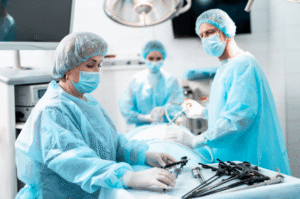
When it comes to surgical treatment, patients are often faced with an important decision: Should I go for laparoscopic (minimally invasive) surgery or open surgery? Both approaches have their own advantages and considerations. Understanding the difference between the two can help you make an informed choice in consultation with your surgeon.
In this blog, we’ll discuss what laparoscopic and open surgery mean, their benefits, risks, recovery times, and most importantly, how to know which one may be right for you.
What Is Open Surgery?
Open surgery is the traditional surgical approach in which the surgeon makes a large incision to directly access the area that needs treatment. For example, in gallbladder removal, the surgeon makes a cut in the abdomen to remove the organ.
Key Features of Open Surgery:
- Involves a large incision (5–10 cm or more).
- Provides the surgeon with direct visualization and access.
- Commonly used in complex or emergency cases.
What Is Laparoscopic Surgery?
Laparoscopic surgery, also known as minimally invasive surgery, involves making small incisions (0.5–1 cm). A thin tube with a camera (laparoscope) is inserted to visualize the internal organs on a monitor, while surgical instruments are used through other small cuts.
Key Features of Laparoscopic Surgery:
- Uses 3–4 small incisions instead of one large cut.
- Guided by a high-definition camera for precision.
- Known for faster recovery and minimal scarring.
Conditions Treated with Laparoscopic and Open Surgery
Both laparoscopic and open surgery can be used for common general surgical conditions such as:
- Gallbladder stones (Cholecystectomy)
- Appendicitis (Appendectomy)
- Hernia repair
- Piles and fissures
- Colorectal surgeries
- Abdominal trauma cases (often open due to emergencies)
Laparoscopic vs. Open Surgery: A Comparison
| Aspect | Laparoscopic Surgery | Open Surgery |
| Incision size | Small (0.5–1 cm) | Large (5–10 cm or more) |
| Pain after surgery | Less pain | More pain |
| Scarring | Minimal, barely visible | Noticeable scar |
| Hospital stay | Short (1–3 days) | Longer (4–7 days) |
| Recovery time | Faster, back to routine in 1–2 weeks | Slower, 4–6 weeks |
| Complications | Lower risk of infection | Higher risk due to bigger wound |
| Cost | Slightly higher in some cases | Generally lower |
Advantages of Laparoscopic Surgery
- Faster Recovery: Patients usually return to normal activities within days.
- Less Pain: Small incisions mean reduced post-operative pain.
- Cosmetic Benefit: Minimal scars, which fade over time.
- Lower Risk of Infection: Smaller wounds heal faster.
- Shorter Hospital Stay: Many patients are discharged the next day.
Advantages of Open Surgery
- Better for Complex Cases: Certain conditions like complicated cancers or major trauma need open access.
- Direct Access: The surgeon can directly see and feel the organs.
- More Affordable: Often less expensive compared to laparoscopic in some hospitals.
Which Surgery Is Right for You?
The choice between laparoscopic and open surgery depends on multiple factors:
- Type of condition (emergency, cancer, trauma, or elective).
- Your overall health (heart, lung, or other medical conditions).
- Previous surgeries (scar tissue may affect laparoscopic approach).
- Surgeon’s expertise.
Always discuss openly with your surgeon to understand which option will give you the best outcome.
Why Choose Dr. Manu Shankar for General & Laparoscopic Surgery in Faridabad?
Dr. Manu Shankar is one of the best laparoscopic surgeons in Faridabad, known for his expertise in minimally invasive surgeries such as gallbladder removal, appendectomy, hernia repair, piles surgery, and more.
- Over 15+ years of surgical experience.
- Expertise in both laparoscopic and open surgery.
- Focus on patient safety, faster recovery, and long-term results.
- Advanced infrastructure and technology at trusted hospitals.
Final Thoughts
Both laparoscopic and open surgery have their own importance in modern medicine. While laparoscopic surgery offers faster recovery and less pain, open surgery is still vital for complex or emergency cases. The best choice depends on your medical condition and the recommendation of your surgeon.
If you are looking for the best laparoscopic surgeon in Faridabad, Dr. Manu Shankar can guide you with the safest and most effective surgical options.
Frequently Asked Questions (FAQs)
- Is laparoscopic surgery safe?
Yes, laparoscopic surgery is safe in the hands of an experienced surgeon. It has a lower risk of infection and quicker recovery compared to open surgery. - Is open surgery outdated?
No, open surgery is still required for complex cases such as trauma or certain cancers. Both techniques are valuable. - How long does it take to recover from laparoscopic surgery?
Most patients recover within 1–2 weeks and can return to normal activities quickly. - Is laparoscopic surgery more expensive than open surgery?
In some cases, laparoscopic surgery may be slightly more costly due to advanced equipment, but the shorter hospital stay often balances the cost. - Which is better: laparoscopic or open surgery?
Neither is “better” for all cases. The choice depends on your condition, overall health, and the surgeon’s advice.

